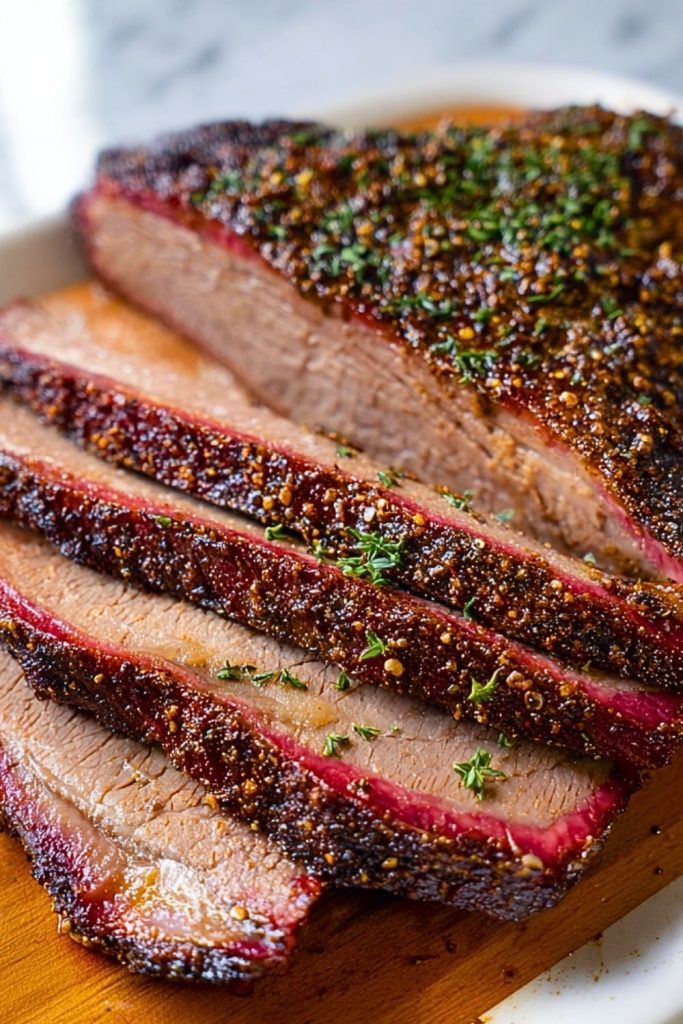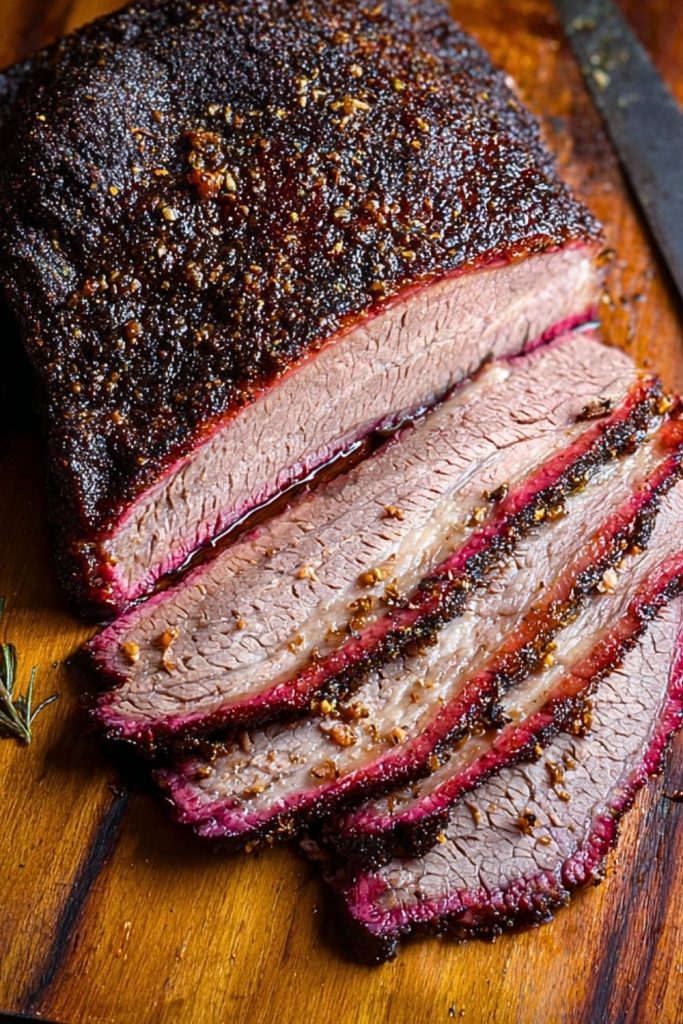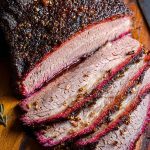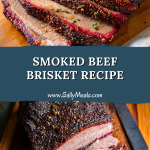I’ve always had a soft spot for smoked beef brisket. There’s something magical about watching a tough cut of meat transform over hours of low, slow cooking into something unbelievably tender and rich with flavor. Every time I fire up the smoker, the anticipation builds — not just for the aroma that gradually overtakes the backyard, but for that first bite of perfectly barked, juicy brisket. It’s more than just a meal; it’s a process I’ve come to love.

This smoked beef brisket recipe is the one I trust most when I want consistent, mouthwatering results. Whether I’m cooking for family, hosting a BBQ, or just treating myself, it never disappoints. With a simple rub, a patient cook, and a little attention to detail, you get meat that slices like butter and melts in your mouth, wrapped in a peppery, smoky crust that’s downright addictive.
Why You’ll Love This Smoked Beef Brisket Recipe
This brisket isn’t just good — it’s unforgettable. You’ll love the balance of simplicity and bold flavor. It uses everyday spices to build a crust that crackles with smoky, peppery depth, while the inside stays moist and packed with beefy richness. And unlike fussy recipes, this one doesn’t demand constant attention. Once it’s on the smoker, it mostly takes care of itself — perfect for lazy weekends or busy gatherings. Plus, the leftovers (if you have any) are even better the next day.
What Cut of Brisket Should I Use?
When it comes to smoking beef brisket, the cut you choose matters — a lot. I usually go for a whole packer brisket, which includes both the point and the flat. The point is fattier and packed with flavor, while the flat is leaner and slices beautifully. If you’re just starting out or cooking for fewer people, you can stick with just the flat. But if you want the full experience — juicy bites with crispy bark and silky fat — the packer is the way to go.
Look for one with good marbling and a thick, even flat. It makes a huge difference in the final result, especially when you’re investing this much time into a cook.
Options for Substitutions
Even though this recipe is built on simplicity, there’s still room to adapt:
- Rub: I use a classic mix of kosher salt and coarse black pepper, Texas-style. You can add garlic powder, onion powder, or paprika for extra depth if you like.
- Wood Type: I stick with post oak for a traditional flavor, but hickory, pecan, or even fruit woods like cherry can change things up nicely.
- Binder: Some people like to rub a thin coat of yellow mustard or olive oil on the brisket before applying the dry rub. It’s optional, but it helps the rub stick.
- Wrapping: If you don’t have butcher paper, foil works fine — just know it may soften the bark a little more than paper.
Smoking brisket is personal, and once you’ve tried the basics, you can tweak it to match your taste.
Ingredients for This Smoked Beef Brisket Recipe
- Whole Packer Brisket (10–14 lbs): This is the star of the show. Choosing a well-marbled brisket ensures a juicy, flavorful result after hours in the smoker.
- Kosher Salt: A coarse salt that seasons deeply without overpowering. It helps form that essential bark on the outside.
- Coarse Black Pepper: Classic in Texas-style brisket, this gives the bark a bold bite and enhances the smoky crust.
- Optional Garlic Powder: Adds a subtle depth to the rub, especially if you’re not going strictly traditional.
- Optional Paprika: A touch of this boosts color and adds a mild sweetness, rounding out the flavor.
- Mustard or Olive Oil (optional binder): Helps the rub stick better to the meat. It doesn’t affect the taste much but can improve crust formation.
- Wood Chunks or Chips (Post Oak preferred): Essential for that authentic smoke flavor. Oak burns steady and gives brisket a deep, rich taste.

Step 1: Trim the Brisket
Start by trimming excess fat from your brisket. Leave about 1/4 inch of fat on the fat cap to keep the meat moist during the cook. Trim any hard, thick pieces of fat that won’t render down.
Step 2: Apply the Rub
If you’re using a binder, rub a thin layer of mustard or olive oil over the entire brisket. Then generously coat it with your salt and pepper mix (or your custom rub). Press it into the meat so it adheres well.
Step 3: Let It Rest
Let the rubbed brisket rest at room temperature while your smoker preheats. This gives the rub time to settle and allows the meat to begin tempering, which helps with even cooking.
Step 4: Preheat the Smoker
Preheat your smoker to 225°F (107°C). Add your wood chunks or chips — post oak if you have it. Let the smoke run clean (thin and blue, not thick and white) before placing the meat.
Step 5: Smoke the Brisket
Place the brisket on the smoker fat-side up. Close the lid and maintain a steady 225°F temperature. Smoke undisturbed for the first 6 hours or until the internal temperature hits around 165°F.
Step 6: Wrap the Brisket
Once it hits 165°F and has developed a deep bark, wrap the brisket in pink butcher paper (or foil if needed). This helps push it through the stall and retain moisture.
Step 7: Continue Cooking
Return the wrapped brisket to the smoker and cook until the internal temperature reaches 200–205°F in the thickest part. Probe for tenderness — it should slide in with little resistance, like soft butter.
Step 8: Rest Before Slicing
Remove the brisket and let it rest (still wrapped) in a cooler or warm oven for at least 1 hour, ideally 2. This lets juices redistribute for cleaner, more tender slices. Always slice against the grain.
How Long to Cook the Smoked Beef Brisket
Cooking time can vary depending on the size of your brisket and how steady you hold your smoker’s temperature, but the general rule is about 1 to 1.25 hours per pound at 225°F (107°C). For a 12-pound packer brisket, expect 12 to 15 hours from start to finish — including wrapping and resting time.
That said, always cook to temperature and feel, not time. Internal temp and the “probe test” are your true guides. Once it hits 200–205°F and feels buttery when probed, you’re there.
Tips for Perfect Smoked Beef Brisket
- Trim Smart: Don’t go overboard — you want enough fat to keep things juicy, but not so much it blocks seasoning or prevents bark from forming.
- Use a Quality Thermometer: Built-in smoker gauges can be inaccurate. A good probe thermometer helps you monitor both meat and smoker temps with precision.
- Avoid Peeking Too Often: Every time you open the smoker, you lose heat and smoke. Trust the process, especially in the first several hours.
- Let the Bark Set Before Wrapping: If the brisket isn’t looking dark and crusty before wrapping, give it more time — bark is crucial for flavor and texture.
- Resting Is Essential: Don’t skip this step. Resting allows the juices to redistribute and the meat to reabsorb moisture, resulting in much better texture.
Watch Out for These Mistakes While Cooking
- Starting with Cold Brisket: Going straight from fridge to smoker can lead to uneven cooking. Let it come closer to room temperature before it hits the heat.
- Under-seasoning: Brisket is a large cut and needs a generous rub to deliver full flavor all the way through.
- Too Much Smoke: Over-smoking can make the meat bitter. Aim for clean, thin blue smoke—not thick and white.
- Rushing the Cook: Trying to raise the temp to speed things up almost always backfires. Low and slow is key.
- Skipping the Rest: Cutting brisket too soon causes all the juices to run out, leaving it dry. Always give it time to rest after cooking.
- Ignoring the Grain: Brisket muscle fibers change direction between the point and the flat. Identify the grain before cooking, and slice across it for tenderness.
What to Serve With Smoked Beef Brisket?
Classic Coleslaw
Its tangy crunch cuts through the richness of the meat and adds freshness to your plate.
Smoked Baked Beans
Rich, hearty, and smoky — they echo the flavors of the brisket and make the meal feel complete.
Jalapeño Cheddar Cornbread
Moist, cheesy, and with a little kick, it’s the perfect bread side to sop up brisket juices.
Pickles & Onions
A Texas BBQ staple. Their acidity balances the fattiness of the meat beautifully.
Potato Salad
Creamy and cool, it contrasts nicely with the warm, smoky meat.
Mac and Cheese
Comfort food at its best. The creamy richness pairs wonderfully with brisket bark.
Grilled Corn on the Cob
Charred corn brings a sweet, smoky element that plays well with brisket flavors.
Texas Toast or Garlic Bread
Great for making mini brisket sandwiches or just mopping up sauce and juices.
Storage Instructions
Leftover smoked brisket stores beautifully if handled right. First, let it cool to room temperature. Then wrap slices tightly in foil or place them in airtight containers with a splash of the cooking juices or beef broth to keep them moist. Store in the refrigerator for up to 4 days.
For longer storage, freeze in vacuum-sealed bags or heavy-duty freezer-safe containers for up to 3 months. Thaw overnight in the fridge and reheat gently — either wrapped in foil in a low oven or steamed for best results. Avoid the microwave unless you’re in a hurry; it tends to dry the meat out.
Estimated Nutrition (per 6 oz serving)
- Calories: 420
- Protein: 36g
- Fat: 28g
- Saturated Fat: 11g
- Carbohydrates: 0g
- Fiber: 0g
- Sugar: 0g
- Sodium: 480mg
- Cholesterol: 115mg
These values will vary depending on the cut of brisket and whether you add any sweet rubs or sauces. The above assumes a traditional salt-and-pepper rub with no sugar.
Frequently Asked Questions
Can I make smoked brisket in an oven instead of a smoker?
Yes, you can replicate the low-and-slow cooking method in an oven. You won’t get the same smoke flavor, but using liquid smoke or smoked salt in your rub can help mimic it.
What’s the stall, and how do I get through it?
The stall happens when moisture evaporating from the meat cools it down, usually around 150–170°F. Wrapping the brisket in butcher paper or foil helps push through this phase faster.
How do I know when my brisket is done?
Don’t rely solely on internal temperature — use a meat probe to test for tenderness. When it slides in with little resistance (like into softened butter), it’s ready.
Should I cook fat-side up or down?
Fat-side up allows juices to flow down, but some prefer fat-side down to shield the meat from direct heat. It depends on your smoker setup. Both ways can work.
Can I cook brisket a day ahead?
Absolutely. Many say it’s even better the next day. Just cool, store properly, and reheat gently before serving.
How do I slice brisket the right way?
Always slice against the grain to keep each piece tender. The direction can change between the flat and point, so adjust as needed.
What’s the best wood for smoking brisket?
Post oak is traditional in Texas, but hickory, pecan, and fruitwoods like cherry also work well. Avoid strong woods like mesquite unless you mix it sparingly.
Why is my brisket dry?
It could be overcooked, not rested properly, or sliced with the grain. Fat content in the cut also plays a role — the point tends to stay juicier than the flat.
Conclusion
Smoking a brisket may seem intimidating at first, but once you go through the process, it becomes a deeply satisfying ritual. The transformation of a humble, tough cut into a smoky, tender feast is pure magic. This smoked beef brisket recipe is all about patience, simplicity, and confidence in the basics — salt, pepper, smoke, and time. With practice, you’ll develop your own rhythm, and soon enough, brisket will become your go-to showstopper for gatherings or even quiet weekends at home.

Smoked Beef Brisket Recipe
- Prep Time: 30 minutes
- Cook Time: 12-15 hours
- Total Time: 13-16 hours
- Yield: 10–14 servings 1x
- Category: Main Course
- Method: Smoking
- Cuisine: American
Description
This smoked beef brisket recipe turns a tough cut of meat into something tender, juicy, and rich with smoky flavor. Perfect for weekend BBQs or any time you want to impress.
Ingredients
1 whole packer brisket (10–14 lbs)
2 tablespoons kosher salt
2 tablespoons coarse black pepper
1 tablespoon garlic powder (optional)
1 tablespoon paprika (optional)
1 tablespoon mustard or olive oil (optional binder)
Wood chunks or chips (preferably post oak)
Instructions
1. Trim excess fat from the brisket, leaving about 1/4 inch of fat.
2. Rub a thin layer of mustard or olive oil on the brisket (optional), then apply the salt and pepper rub.
3. Let the brisket rest at room temperature while the smoker preheats.
4. Preheat your smoker to 225°F and add wood chunks or chips.
5. Place the brisket fat-side up on the smoker and cook undisturbed for about 6 hours or until internal temp reaches 165°F.
6. Wrap the brisket in butcher paper or foil and return to the smoker.
7. Continue cooking until internal temp reaches 200–205°F and it feels tender when probed.
8. Remove from smoker and rest wrapped in a cooler or warm oven for at least 1 hour.
9. Slice against the grain and serve.
Notes
Store leftovers wrapped or in airtight containers for up to 4 days in the fridge, or freeze for up to 3 months.
Reheat gently in foil in the oven or by steaming for best results.
Nutrition per 6 oz serving: 420 calories, 36g protein, 28g fat, 11g saturated fat, 0g carbohydrates, 0g sugar, 480mg sodium, 115mg cholesterol.
Nutrition
- Serving Size: 6 oz
- Calories: 420
- Sugar: 0
- Sodium: 480
- Fat: 28
- Saturated Fat: 11
- Unsaturated Fat: 15
- Trans Fat: 0
- Carbohydrates: 0
- Fiber: 0
- Protein: 36
- Cholesterol: 115

